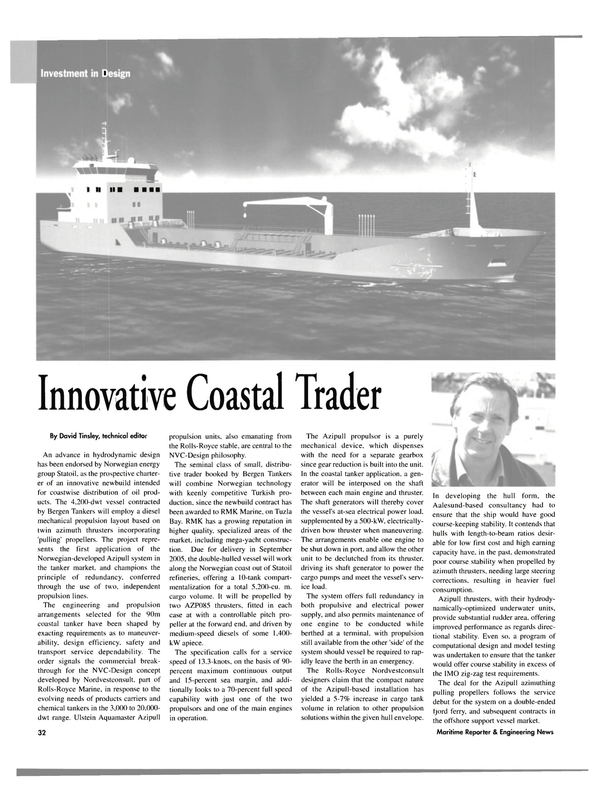
Car Ferry Saves Fuel with New Engines
Northern Norway has a large fleet of small and mid-size boats for commercial operations, for example, passenger boats, car ferries and a multitude of fishing boats. These are boats that operate year around and that at regular intervals need to replace their engines.
The high-speed passenger boat MF Sjosprint was equipped at the end of last year with twin Volvo Penta D12s for propulsion, a move which reportedly helped reduce fuel consumption 30 percent compared with the old engine, while at the same time performance has improved.
The MF Flatoy car ferry installed a D12 last May. "Volvo Penta engine has operated problem-free and has a very low noise level, which is comfortable for us working onboard," says Torgier Gamst on the MF Flatoy. "Fuel consumption is also significantly lower. Previously, we consumed 6.3 liters per nautical mile, compared with 4.9 liters today, a decrease of about 25%, or approx.
44,000 liters annually." The manufacturer claims that many of the operational benefits are due to the engine's advanced electronic control. The fuel system, with single injectors working under very high pressure, is controlled fully electronically. Consequently, in each situation, the exact amount of fuel is injected into each cylinder. Turbo with charge-air cooling and fourvalve technology ensures efficient combustion, resulting in low fuel consumption and minimal exhaust emissions.
Circle 2 8 on Reader Service Card
Read Car Ferry Saves Fuel with New Engines in Pdf, Flash or Html5 edition of February 2004 Maritime Reporter
Other stories from February 2004 issue
Content
- Northrop Grumman Delivers Aegis Destroyer page: 3
- Izar Gijon Delivers Two Massive Dredgers page: 10
- Boeing Connexion Moves to the High Seas page: 10
- New Ferries for Hawaii? page: 11
- Damen Delivers First-of-Class ASD Tug page: 12
- OMI Pleads Guilty to Illegal Dump, To Pay $4.2M Fine page: 14
- Teekay Orders Aframax Tankers page: 15
- Wartsila to Discontinue Production in Turku page: 15
- China Preps To Take World Lead page: 16
- Secondhand Prices Tanker Prices Up 35% page: 16
- Continuous Synopsis Record page: 18
- A 3D Virtual Interface to Access Ship Data page: 20
- MAN B&W Debuts ME-GI Dual Fuel Engine page: 21
- Rebuilding Single Hull Tankers to Double Hull Tankers page: 22
- Thor-Lube Stern Tube Bearing System on Shell LNG Carrier page: 24
- K-Sea Acquires Integrated Tug Barge Unit page: 25
- Boosting Deepsea RoRo Capacity page: 25
- MTS Rosette: State of the Art Inland Tank Ship page: 26
- Fourth New ATB Tank Vessel for MTC page: 30
- Company Focus: Staying Connected with INTERCON page: 31
- Innovative Coastal Trader page: 32
- Halifax Shipyard On Hand To Replace Lost Rudder page: 33
- East Isle Shipyard Wins $16M Contract page: 34
- Transport Canada Takes Lead on Safety page: 35
- Hike Metal: Steady Progress to Success page: 36
- Car Ferry Saves Fuel with New Engines page: 37
- The ISPS Code page: 38
- Temporary Hull Repair on FPSO Stands the Test page: 39
- New 12,000-sq.-m. Workshop Pays Dividends page: 41
- Series Design in the New Regs Environment page: 42
- Aluminum Boats Prove Their Mettle page: 44
- Success Aboard QM2 page: 49
- LCD's Turning Black page: 50
- The Needs of Maritime Electronic Equipment page: 51
- Advantage of Marine Guard Foam Filled Marine Fenders page: 52


